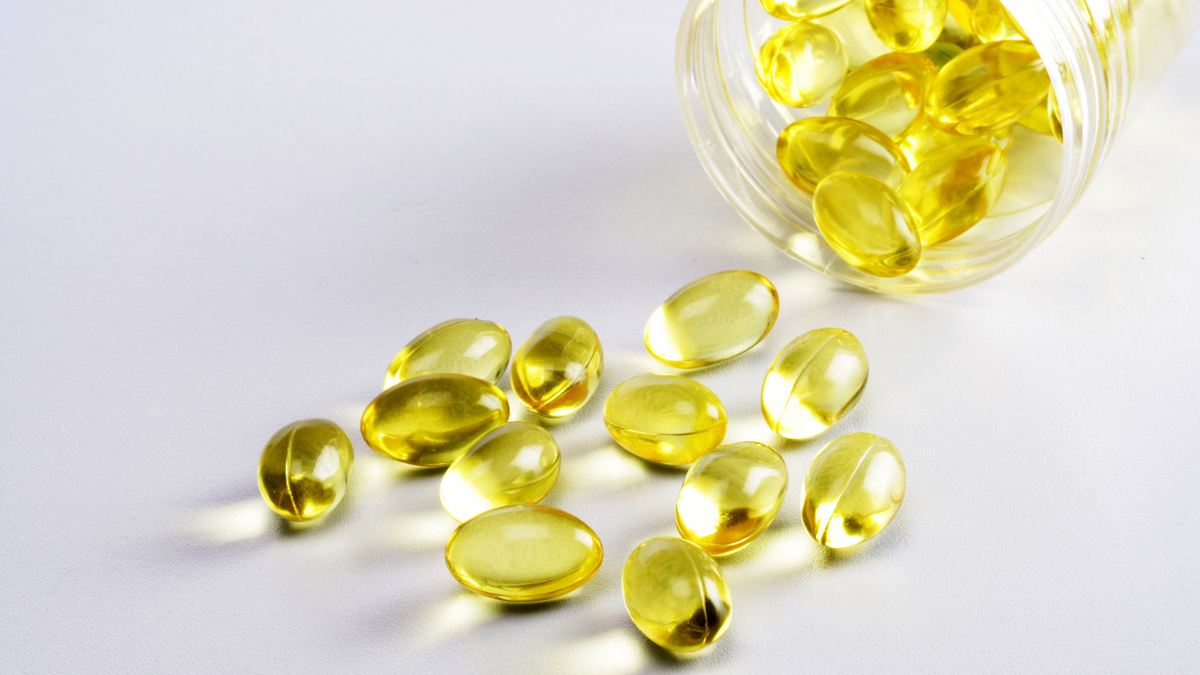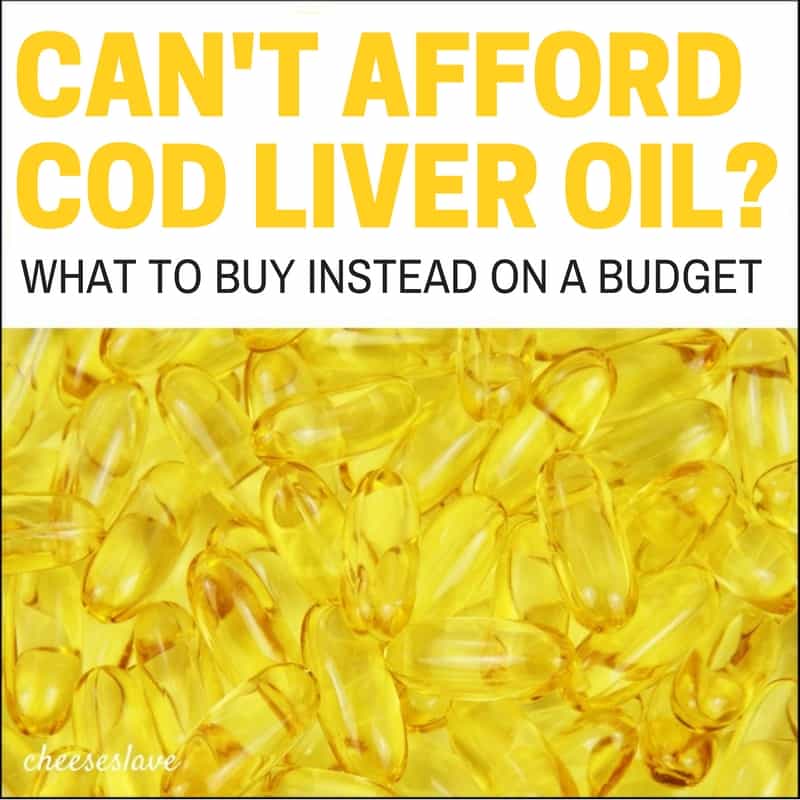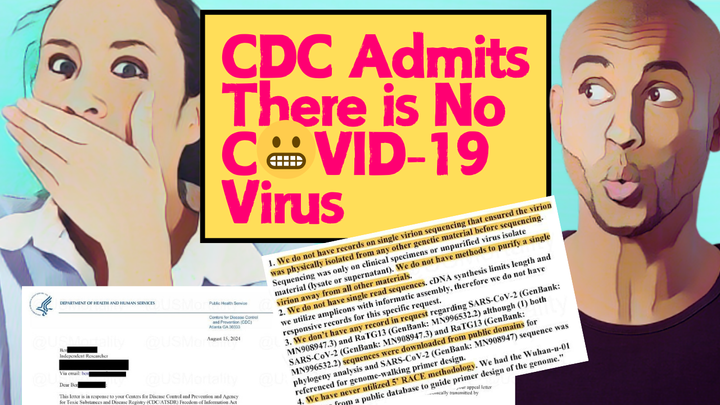Can’t Afford Cod Liver Oil? What To Buy Instead If You’re On a Budget
Can’t afford cod liver oil? In this post I’ll talk about what to buy instead of cod liver oil and how to save money getting the nutrients cod liver oil offers.

Can’t afford cod liver oil? In this post I’ll talk about what to buy instead of cod liver oil and how to save money getting the nutrients cod liver oil offers.

Please note: I have affiliate links in this post. I make a small commission when you order via my affiliate links. However, I only recommend brands I trust. Thank you for helping to support my blog!
What If You Can’t Afford Cod Liver Oil?
Last week I published a post comparing 10 cod liver oil brands. Based on the research I did, I can only recommend one brand of cod liver oil, Rosita EVCLO. One of my readers asked me on Facebook what to do if she could not afford to buy Rosita EVCLO.
Eileen wrote:
So, my biggest question is if one cannot afford to buy Rosita’s brand due to income and family size, should one just skip cod liver oil all together?
We eat a whole foods, nourishing diet. make just about everything from scratch and barely squeak by with a $150/week budget for a family of 5.
We already employ just about every savvy saving technique we can. If each of us were to take a tsp of Rosita brand a day we’d need two bottles/month and we just don’t have that money to spare.
So if you’re a moderate income family there’s simply no options? That feels like such a bummer to me.
I Love Saving Money!
I love this kind of challenge! When I got Eileen’s comment, I immediately sat down with a glass of wine and a Google drive spreadsheet and started crunching the numbers.
Okay, so as some of you know from my recent Facebook livestreams, I am currently on a quest to cut our food budget in half. My husband told me recently that he wanted us to save money on food, and me being the Type A go-getter than I am, I decided I want to try to cut our costs by 50%. So my mind has been brewing with all kinds of ideas.
How can Eileen justify adding $100 extra ($50 per bottle for 2 bottles per month) to a monthly food budget of $600? That’s an increase of almost 20%!
As I said in my other post, none of the other cod liver oil brands are worth buying for a variety of reasons (the biggest one being that they almost all have added vitamins because the high-heat processing destroys the vitamins… so it’s kind of like buying vitamin-fortified cereal. If they don’t add vitamins back in, then they have the wrong ratio of A/D… except for Rosita EVCLO).
If Eileen can’t afford to buy Rosita EVCLO, then she just should not buy cod liver oil.
However, I was very confident that I could tell Eileen that she could buy different, much cheaper foods to take the place of cod liver oil. I was sure I could find lower-cost foods to replace the cod liver oil and save her at least 80%.
I was wrong.
How to Save Money on Cod Liver Oil: My Cost Saving Strategy
Okay, let me walk you through my ideas and I’ll show my work.
Let’s start by saying that Rosita EVCLO will run you around $46 per month if you take 1 teaspoon per day every day. So we need to beat that cost.
Why Buy Cod Liver Oil?
We buy cod liver oil for 3 reasons: vitamin A, vitamin D and omega-3 fatty acids.
If you read Dr. Weston Price’s book, Nutrition and Physical Degeneration, you said the healthy populations he studied got 10 times more fat soluble vitamins (vitamins A, D and K2) than the Americans in his day (the 1930s).
As far as omega-3s go, if you read my cod liver oil brand comparison post, I talk about how our omega-6/omega-3 ratio is out of whack due to modern vegetable oils and CAFO meat, eggs and dairy, and how important it is to consume more omega-3s to correct this ratio.
All right, so we need vitamins A and D, and omega-3s. I know that there are lots of ways to get these nutrients other than cod liver oil. And there are lots of cheap ways to get them. So… I figured I would just recommend to Eileen that she can buy the cheaper foods to supply the vitamins A and D, and omega-3s, and voila! She saves money not buying cod liver oil.
What Are the Best, Most Inexpensive Substitutes for Cod Liver Oil?
So I thought about it and asked myself, what are the most inexpensive yet accessible (available from a farm or Amazon) food sources for these nutrients? Keep in mind, they need to be grass-fed, organic and/or wild-caught (in the case of seafood).
Here’s what I came up with:
- Vitamin A – Beef Liver
- Vitamin D – Canned Salmon
- Omega-3 Fatty Acids – Canned Salmon
Now, of course, there are other sources of vitamins A, D and omega-3s. You don’t need to eat these things. Cheese, butter, cream and egg yolks are also good sources of vitamin A. You can get the same amount of vitamin D from 2 4-ounce servings of salmon per week. But salmon costs a lot more.
So what I tried to is find the very best food sources (highest levels of these specific nutrients) that also happen to be the cheapest (most inexpensive) sources.
Notes: I used the USDA database for all of the nutrition data. Pastured/grass-fed foods may be higher in nutrients but we don’t have tests for them.
For the omega-3s, I used this source.
All the amounts for servings are for adults. For children, you would cut them in half. (In other words, a child would only need to eat 1.75 ounces of beef liver per week.)
1. Vitamin A: Beef Liver
1 teaspoon of Rosita EVCLO per day gives you about 2,500 IU vitamin A per day, which is about 17,500 IU vitamin A per week.
One 3.5 ounce (100 grams) serving of beef liver per week gives you the same amount of vitamin A.
I found pastured organic beef liver online for $6 per pound (you might be able to find it cheaper).
Cost per week = $1.31
Cost per month = $5.24
We are way under budget so far!
Keep in mind, it’s only beef liver that will give you this amount of vitamin A. With chicken liver, you’ll need to eat more since it is lower in vitamin A.
What About Desiccated Liver?
If you can’t stomach the idea of eating beef liver, you could also take desiccated beef liver for vitamin A. The most [easyazon_link identifier=”B01A17E7Y6″ locale=”US” tag=”cheeseslave0e-20″]inexpensive brand I found on Amazon was this one[/easyazon_link]. I’m not familiar with this company. (I like [easyazon_link identifier=”B00V7COK0G” locale=”US” tag=”cheeseslave0e-20″]Vital Proteins brand[/easyazon_link] — I know them personally, but it’s more expensive.) The [easyazon_link identifier=”B01A17E7Y6″ locale=”US” tag=”cheeseslave0e-20″]cheaper brand[/easyazon_link] is $19 for 1 bottle (90 grams). To get the same amount of beef liver, you’d have to take a whole bottle a week (90 grams = about 3.17 ounces). $19 x 4 weeks = $76. Way too expensive.
Another idea is to make your own desiccated liver. You can dry beef liver in a dehydrator and take a little every day as a powder or add it to smoothies. I know a lot of people who do this.
Other Options Besides Beef Liver
If you don’t want to eat beef liver once a week, to get 2,500 IU of vitamin A per week, you would have to eat…
Cheese: Over 9 ounces of per day
Butter: 6 tablespoons per day
Heavy cream: Almost 6 ounces per day
Egg yolks: 10 egg yolks per day
Salmon roe: 5 tablespoons per day
Now, granted, you would be mixing that stuff up… for example, every day you could eat 3 egg yolks, 1 tablespoon of butter, 4 ounces of cheese, and 2 ounces of heavy cream in your coffee. That’s do-able. But how much is it going to cost? That’s $1.40 per day just for 3 egg yolks, which is over $10/week and $40/month.
And remember, we are trying to eat 10x what the people in Weston Price’s day ate. So you can see, it’s just easier to eat your one serving of liver per week. That’s why our great-grandmas did it! They ate their liver once a week in addition to all the butter and cream and egg yolks they ate (which was a lot back in the 1800s and early 1900s — check out any old cookbooks online and you’ll see.)
2. Vitamin D: Canned Salmon
Okay, onto vitamin D.
The sun is the cheapest source of vitamin D. It’s free! But getting sun is not as easy as we’d like. Most of us have to work and our kids are indoors in school all day, so it’s hard to make sure we get adequate sun, baring our skin, during the prime mid-day hours. It also depends on where you live, how dark your skin is, whether or not you are obese, and other factors. For example, if you live in the northern hemisphere, it takes longer to get vitamin D from the sun. The darker your skin is, the more time you need to spend in the sun. And if you are obese, it takes longer to get vitamin D from sunshine. Also, sunscreen blocks 95% of vitamin D absorption.
So let’s assume most of us are not getting enough sun and move onto the best inexpensive food source which is canned sockeye salmon, sardines are actually cheaper but they have less vitamin D according to my sources — see below).
1 teaspoon of Rosita EVCLO per day provides around 500 IU vitamin D, which is about 3,500 IU vitamin D per week.
You would need to eat 2 ounces or [easyazon_link identifier=”B0049J2B2I” locale=”US” tag=”cheeseslave0e-20″]canned sockeye salmon[/easyazon_link] per day (or 1/3 of a can each day, roughly 2 cans per week). That costs $1.42 per day.
Cost per week = $9.94
Cost per month = $39.76
If you add the $5/month for the beef liver, you’re at around $45/month. 1 teaspoon of Rosita EVCLO costs $46/month. You saved a dollar.
Other Options Besides Canned Salmon
If you don’t like canned salmon (I’ll be honest… I don’t love it), you could eat broiled or grilled salmon… but it’s going to cost a lot more.
So what about other sources of vitamin D? To get the same amount (500 IU per day) as one teaspoon of Rosita EVCLO, you would have to eat:
Lard: Ahhh! Are you kidding me?! 38 tablespoons per day. Noooooo!!!! LOL! (The USDA says lard only has 13 IU of vitamin D per tablespoon; other sources say lard has more vitamin D, and maybe it does if it’s pastured, but I don’t have a good source for nutrition data. Maybe someone can comment below?)
Sardines: Only 38 cents per ounce (cheap!) but you would have to eat 2 4-ounce cans per day, or 14 cans per week. Blecchh! Reminds me of that movie, Cloudy with a Chance of Meatballs — the town where everyone ate sardines all the time. And it would cost you $93/month. Budget blown.
Yeah, you can see, it’s hard to get much natural vitamin D from the diet. You could always take a vitamin D3 supplement, but considering it’s made from lanolin (sheep wax), I really don’t recommend that. (I talk about why I don’t recommend D3 from lanolin in my cod liver oil comparison post.)
3. Omega-3s: Canned Salmon
OK, we’re not done yet… let’s talk about the omega-3s. You’re definitely going to get it from the canned sardines or salmon… but how much do you need to eat?
1 teaspoon of Rosita EVCLO provides 1,300 omega-3s per day, which is about 9,100 omega-3s per week.
To get the same amount, you need to eat 3 ounces per day of the canned sockeye salmon. So let’s increase that… now you’re eating 21 ounces per week (or 3.5 cans per week).
Cost per week = $14.91
Cost per month = $59.64
So now we’re over the $46/month budget.
OK… you DO get omega-3s from grass-fed meat, dairy and eggs. So I think you can stick to the 2 ounces per day of canned salmon and make sure you’re eating plenty of pastured meat, dairy and eggs. Add one 3-4 ounce serving of liver once a week and you’re golden.
But you are not going to save any money. The Rosita EVCLO costs the same.
Conclusion
Even if you can get a lot of vitamin D from sunshine, which is free, and you get your vitamin A from beef liver (only $5 per month), you still need to find a way to get those omega-3s that are so critical to health.
Most health/nutrition experts say we need to be getting a minimum of 250-500 mg of omega-3s per day. While you can get omega-3s from grass-fed meats and dairy, seafood really is the best way. To get 250 mg of omega-3s per day, you need to eat around 8 ounces of seafood per week (that’s two 4-ounce servings). Plus you get iodine from seafood, which we haven’t even talked about.
Again, eating wild-caught seafood a few times a week is a lot more expensive than canned salmon.
I think this just shows how affordable and convenient Rosita EVCLO really is. For me, it’s insurance. We are covering all the bases*, and it’s extremely affordable when you consider the nutrients you are getting.
I like liver, and I eat it here and there, but I don’t want to have to eat it every week. I do eat a lot of seafood in addition to taking my Rosita EVCLO, but more omega-3s are even better!
Here’s what I think… If you have issues that you are trying to resolve, supplementation may be essential for you. For example, if you are recovering from illness. If you have a child on the autism spectrum (they really need vitamin A). Or like me, if you want to improve your eyesight (again, vitamin A).
If you can’t find a way to afford quality supplements, and your family is relatively healthy, you can skip it. I don’t think everyone needs to take cod liver oil.
My point is I’d rather see people skip the supplements instead of buying cheap supplements. I know so many people taking cheap brands of cod liver oil and it’s just not worth it. The bottom line is, you get what you pay for. And it costs money to buy real food.
That said, there are plenty of ways to cut your budget to be able to afford supplements like cod liver oil and emu oil (see below re: vitamin K2). I’m going to be working with Eileen (the OP or original poster above) to figure out how she can trim her budget to be able to afford EVCLO.
For example, buying whole chickens instead of chicken breasts can save you a ton of money. Making homemade water kefir soda from sugar, water and fruit costs 1/3 of what soda costs (organic or even just regular Coke). Making your own bread costs 1/3 of what it costs to buy bread at the store. Those are just few ideas.
I will be posting a whole series of articles on saving money on real food. Stay tuned.
*Note: You need to also consume vitamin K2 along with the other fat soluble vitamins, A and D. The easiest way to do this is in the form of grass-fed butter, ghee, cream and/or cheese. The dairy products made from milk from cows eating rapidly growing green grass (spring grass) have the highest levels of K2. You can also get much higher levels of vitamin K2 by taking emu oil, which is off the charts. If you have issues like bone loss, cavities, heart disease, I recommend increasing your K2.
Questions? Please Comment Below
Please comment below with your questions or ideas or anything you’d like to share.



Comments ()